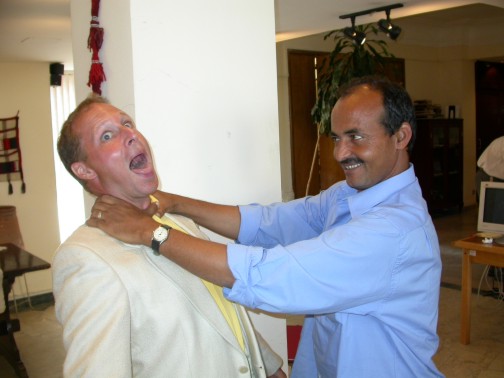And now. . . .the news from the EEFPress report: "Loss of Curators' Power Seen in Brooklyn Museum Plan"
http://snipurl.com/s53e[http://www.nytimes.com/2006/06/22/arts/design/
22muse.html?_r=1&oref=slogin]
[if registration is needed, use "eefeef" for id and password.]
"Beginning next month, the Brooklyn Museum will do away with
traditional departments like Egyptian art, African art and European
painting and instead create two "teams," one for collections and
one for exhibitions. ... Some critics have complained that the
museum is taking the theme of accessibility so far that it is
undermining its strengths as a place respected for its scholarship."
Press report: "A trifle over bazaars"
http://weekly.ahram.org.eg/2006/799/heritage.htm"Problems surrounding the Karnak Development Project
still seem unsolved despite the reported approval of all
concerned.....Part of the project's plan involves the
demolition of the French mission's residential compound
and the 19th-century-dig house of French Egyptologist
George Legrain. ...According to the existing plan the
Gournah residents will be moved to Al-Taref, outside Luxor.
The worst of their houses will be demolished while other
those in good condition will be left in place, but without
inhabitants. ..."
Dr Zahi Hawass's 'Dig Days' column is again about "the tunnel of
the tomb of Pharaoh Seti" and the supposed chamber there:
http://weekly.ahram.org.eg/2006/800/hr1.htm[Ed. Actually, not much about the Seti tomb itself -- which has long been rumored to possibly contain a spectacular untouched burial chamber behind the blocked-up end -- but of some German guy who wanted to raise money to clear it out.]
Dr Hawass is planning an exhibition about the two mummies
from KV60. It has been confirmed by eye-witnesses that the
mummy that had remained in KV60 was taken out and moved
to Cairo in mid May. This explains the garbled press report
listed in EEFNEWS 408:
http://www.sis.gov.eg/En/EgyptOnline/Culture/000001/0203000000000000000628.htmThis remaining mummy was proposed to be Hatshepsut
by some, but NOT by Hawasss, who thinks it is Sitre
Macquarie University News of June 2006 has an online
article called "Animal behaviour in ancient Egypt":
http://www.pr.mq.edu.au/macnews/ShowItem.asp?ItemID=482"World-first PhD research at Macquarie University is
looking at the way animal behaviour is represented in
Egyptian wall scenes. Experts say it will change the
way ancient Egyptian tomb art is interpreted. "
About the work of Linda Evans, a research assistant
at Macquarie University's animal behaviour laboratory.
Online version of: Michael R. Jenkins, "The stela of Neferhotep
from the Sanctuary of Heqaib on Elephantine Island", in: JEA, vol. 82,
pp. 199-202 (1996)
http://www.maat.com.au/Neferhotep.html"Report of the discovery on Elephantine of a XIIIth Dynasty limestone
stela from the Sanctuary of Heqaib. The owner, the Elder of the Portal
Neferhotep, born of Nubhertjen, is otherwise unknown." [AEB]
* Online version of: Michael R. Jenkins, "Notes of the Tomb
of Setka at Qubbet el-Hawa, Aswan", in: BACE, vol. 11,
pp. 67-81 (2000)
http://www.maat.com.au/Setka.html"On 9 December, 1993, I was granted permission to make
measurements, notes and photographs of the tomb for a three
hour period in the company of Mr Nasr Salama, Inspector of
Aswan Antiquities for the Egyptian Antiquities Organisation.
This paper is based on the field-notes and photographs taken
by myself at that time and is intended only to highlight some
of the interesting structural features and decorative elements
of this little-known sepulchre."
* Online version of: Cheryl Ward, "Boat-building and its
social context in early Egypt: interpretations from the First
Dynasty boat-grave cemetery at Abydos", in: Antiquity,
vol. 80, pp. 118-129 (2006) - pdf-file: 250 KB
http://www.anthro.fsu.edu/people/faculty/ward/ward2006.pdf"The boat-grave cemetery at Abydos has provided the world’s
oldest sewn planked hulls, and vivid evidence for the way early
Egyptian wooden boats were built. As well as sailing on the
Nile, they were designed to be dismantled for carriage over
land to the Red Sea. By the mid-fourth millennium BC the ship
was a major technical force in the Egyptian political economy
as well as an iconic force in ceremonial burial."
Online review of: T G H James, The British Museum
Concise Introduction ANCIENT EGYPT, 2005, The
American University in Cairo Press.
http://weekly.ahram.org.eg/2006/800/hr3.htm

